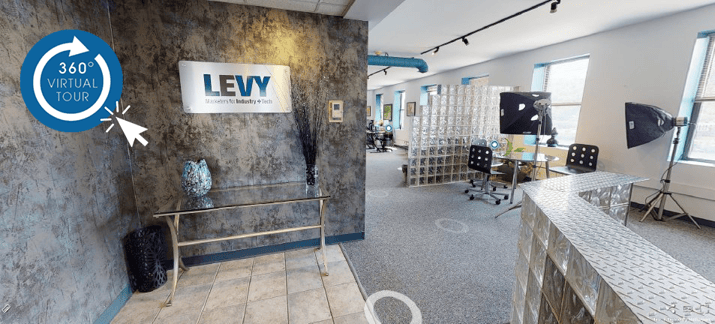
Customers Can’t Come to You? You Can’t Visit Customers? Now What?
Time to Rethink Importance of Face-to-Face Meetings
by Francois Gau
Coronavirus has changed the way we live and work, accelerating many trends that were already in motion, such as brick-and-mortar retailers struggling to compete with online merchants.
 The pandemic has also accelerated changes already underway in the realm of industrial buying. Those habits, such as frequent face-to-face visits, are unlikely to revert to previous form regardless of how quickly a vaccine or cure becomes available.
The pandemic has also accelerated changes already underway in the realm of industrial buying. Those habits, such as frequent face-to-face visits, are unlikely to revert to previous form regardless of how quickly a vaccine or cure becomes available.
That’s because people have discovered that Zoom, Teams, Skype, UberConference, Slack, Wrike and Asana allow them to interact productively without being in the same room.

Although attending a tradeshow or conference and enjoying a leisurely lunch or dinner are effective ways to establish or strengthen relationships with prospects or customers, for better or worse, they are no longer essential. As a result, many of us need to continue adapting to this new normal.
In today’s world of industrial buying, after two parties establish trust and sign a contract, efficient collaboration can occur through videoconferencing and email, with onsite visits happening only when absolutely necessary, such as to install or repair a piece of equipment or system, or to see a prototype in action and modify it “on the fly” to optimize performance.
The way I see it:
- We NEED to get sales leads to visit, connect, interact, learn, and ENGAGE with our brand. (i.e., our company’s culture and what people expect from the products we provide)
- We NEED prospects to BUY from us, and not from our competitors.
Engaging with Our Brand
Changing demographics, another pre- COVID-19 trend, will continue have a profound impact on industrial marketing and sales.
As Millennials (Gen Y, currently ages 25-40) continue their ascent to managerial and executive positions, we must provide quotes and product information at warp speed instead of days or weeks later to coincide with a visit, and order fulfillment must occur equally fast.
This new generation of leaders and managers are “digital natives” who grew up using the internet to access anything and everything, anytime from anywhere, and entertain themselves extensively with online content. As a result, they value instant responses over the longer cycle times required by face-to-face contact.
This reality will become more embedded in business culture as members of the Gen Z cohort (people currently between the age of 10-25) become a larger percentage of the workforce.
Gen Zers check their email several times a day and tend to receive fewer emails than their Millennial counterparts, so it’s easier to “cut through the clutter” by incorporating email into your strategy for reaching this demographic. As Gen Zers get older and become a larger percentage of the workforce, email should remain an effective means of communication because they prefer it to instant message much more than Millennials, which keeps inboxes clean.
Gen Zers are also more socially conscious than previous generations and want to do business with companies that have ethical missions which go beyond making money.
Apple’s mission, for example, is “to bring the best user experience to customers through our innovative hardware, software, and services.” Ours, at LEVY, is “to Make Marketing Count.” What’s yours, and how does it track with what you do every day? How often do you share it with customers and prospects?
In short, a simple website is just not good enough. After two years at LEVY, I am finding that industrial brands are no different than consumer ones. Engagement is key. We need to talk to prospects and customers continually about topics that matter to them on an emotional level in addition to conveying information about our products and services. In our jargon, this is often called inbound marketing. The idea is to relentlessly become the thought leader into that “something special” you do. It’s hard work, but it’s the only way forward I know.
Buying Our Products or Services
In our world of industrial buying, marketing is usually limited to listing features and benefits such as “here’s what we have, this is what it does, and trust us because we’re better, cheaper….”
Sales are usually collaborative and highly technical. In some instances, we must become a “certified” supplier to conform to a customer’s specific needs or industry standards. We often must engineer, develop, prototype, test, re-do the prototype multiple times, “run-off,” etc. Eventually, we get to production.
Assuming we have everything aligned perfectly at that stage of the sales cycle, we are close to a “deal.” It’s between us and “the other company” (i.e., our most direct competitor). If we can’t get prospects to visit us as they used to, how do we get them sufficiently comfortable to do business with us?
A Sweeping View
An effective way to bring prospects, customers, suppliers, strategic partners, and others into your facilities without compelling them to spend the time and money necessary to walk through your doors is to make interactive virtual tours available to them.
For years, the real estate industry has made effective use of virtual tours to acquaint potential buyers with commercial and residential properties alike, as well as with areas surrounding those properties.
Using a special 360° camera, it’s now possible to employ a combination of virtual and augmented reality (computer-generated images and meta data, such as products, services, people and videos, super-imposed on physical images) to show your target audiences as much of your facilities as you would like them to see. In addition, we can explain to them through a virtual reel, or “walk through,” how our people, technology, and processes can make a difference and why we’re unique.
The result is that a visit which used to require days or months to plan now takes minutes. You can integrate this tool with your lead conversion program as part of your proposal development process. It’s highly effective based on what I often hear: “When they visit, they almost always buy.” If they can’t come to you physically, make them come virtually.
Since this tool is online, if people have questions, they can email or call you, or reach out to you on a social media platform. This approach is highly engaging and can be embedded in your outreach campaigns.
Over the past few months, we have created several of these “virtual tours,” starting with our own offices in Pittsburgh:
It took us about a half-day to shoot footage and another half-day to “jazz it up” with augmented reality images, videos, links, and other elements that increase the tour’s interactive features.
This straightforward process consists of you making your facility “camera-ready” by cleaning the appropriate areas and removing proprietary content that the high-resolution 360° camera could record.
A crew then visits your site to get 360° shots of the desired areas. It can take an hour to process images of 2,000 sq. ft., so, for most of us, the video shoot can take a while. Ideally, we shoot footage during maintenance or off shifts. To achieve the most effective imagery, the video should show stationary objects only -- no moving people or parts, including conveyers, pallets, and cranes.
Following the shoot, you work with a digital production team to edit footage by adding text and images, videos, and links at all strategic locations in your shop that best promote your capabilities.
After editing is complete, the video is published online and can be shared on all your social media platforms and marketing channels. It contains a feature that allows you to track and analyze who’s taking the virtual tour and when they took it, so you can follow up with them as appropriate.
As we discussed, I started this journey to bring clients into our shop. It’s been highly beneficial, and we’ll continue to leverage that investment to “make our marketing count.”
A virtual tour can also be an effective tool for:
- Supplier onboarding or audits (pre-visit planning)
- Recruiting new talent
- On-boarding new team members
- Training staff (e.g., safety, equipment use)
- Reaching out to members of the community
- Collaborating with research partners in academia
- Much more
We’re living at a time when factors related to public health, economics and demographics are converging to make online communication the meeting tool of choice. Those who adapt to this new reality will find opportunities while those who don’t will become irrelevant.
Because it’s always more effective to show something to someone rather than tell him or her about it, see what my team did to familiarize people with our firm.
We can do the same for you, whether you want to showcase your production capabilities, office space or both. Call us, and we’ll get you started with the process.
###

Francois Gau is President and CEO of LEVY Marketers for Industry + Tech (www.levyind.com), a strategic business development full-service marketing firm that uses a mix of digital and traditional marketing channels to create brand awareness, increase sales, and improve communications for manufacturers and technology companies worldwide. LEVY is based in Pittsburgh and has been in business for more than 30 years.